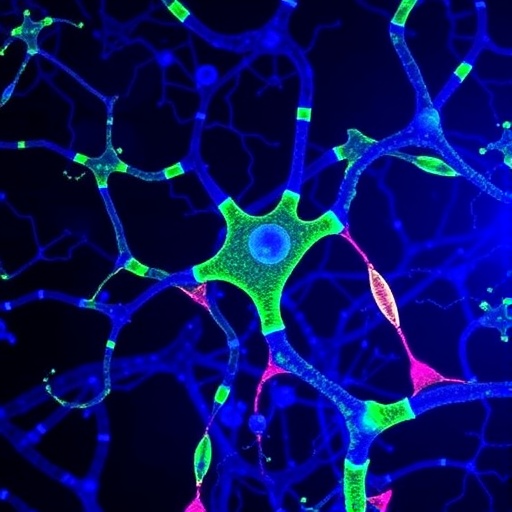In the ever-evolving landscape of molecular imaging, scientists are constantly seeking innovative methods to enhance the visualization of specific biological processes. A recent breakthrough in this field comes from a substantial study focused on the development of a novel imaging agent. This agent revolves around a specifically designed compound—an ^18F-labeled 1,5-diarylpyrrole derivative aimed at elucidating the expression of cyclooxygenase-2 (COX-2) in various pathological conditions. The implications of this research could be profound, especially in diagnosing and monitoring therapies for inflammatory diseases and cancers.
The synthesis of this ^18F-labeled compound marks a significant milestone in the realm of radiopharmaceuticals. The design and execution of such a synthesis require intricate knowledge of organic chemistry and radiochemistry, as the addition of fluorine-18—a positron-emitting isotope—demands precise handling due to its rapid decay and short half-life. The team, led by researchers Miao, Yang, and Peng, undertook meticulous steps to craft this imaging agent, which is not only optimized for labeling but also effective for targeting COX-2 expression.
COX-2, an enzyme that plays a critical role in inflammation and pain, is overexpressed in many cancers, making it an attractive target for diagnostic imaging. Previously, imaging techniques lacked specificity, often leading to ambiguous results. This new ^18F-labeled derivative seeks to address that gap by enabling clearer and more differentiated imaging of COX-2 levels in vivo. Such an advancement can lead to improved diagnostic accuracy, thereby allowing clinicians to tailor treatments more effectively based on the specific inflammatory profiles present in tumors or other tissues.
The preclinical evaluation of this ^18F-labeled 1,5-diarylpyrrole derivative included a series of detailed studies involving binding affinities and biological evaluations. These studies confirmed not only the capability of the compound to bind selectively to COX-2, but also its favorable pharmacokinetic properties. This is essential because optimal imaging agents need to have a balance between tissue retention and rapid clearance from the bloodstream to ensure clear imaging results.
Assessment of the biological activity revealed promising findings. Miao and colleagues conducted experiments that demonstrated significant uptake of the compound in COX-2 overexpressing tissues while minimizing accumulation in non-target organs. This selectivity is crucial for accurate imaging, as it mitigates the likelihood of false positives that could stem from background noise in the imaging data. The preclinical studies provide a strong foundation for the future application of this compound in clinical settings.
Advanced imaging techniques, such as positron emission tomography (PET), are increasingly being employed in conjunction with these novel agents to visualize biochemical processes in real time. The developed ^18F-labeled 1,5-diarylpyrrole not only shows promise as a reliable imaging marker for COX-2 expression, but it also represents a stepping stone towards personalized medicine. By providing insights into individual patient profiles, it allows for more informed decisions regarding treatment approaches, ultimately improving patient outcomes.
In terms of potential applications, the compound’s ability to visualize COX-2 expression could have far-reaching impacts across oncology and rheumatology. In oncology, for instance, it could be used to evaluate tumors’ inflammatory microenvironments, guiding oncologists in administering targeted therapies that inhibit COX-2 or in determining the most effective anti-inflammatory agents as part of a combination therapy. In rheumatology, tracking COX-2 levels could lead to a better understanding of disease progression in conditions such as rheumatoid arthritis, allowing for proactive management strategies.
Moreover, the need for translatable research to the clinic cannot be overstated. As the team prepares to transition this agent from preclinical studies to human trials, the collected data will be instrumental in attracting collaboration with clinical researchers and pharmaceutical companies interested in developing adjunct therapies utilizing COX-2 inhibitors. This pathway not only improves the therapeutic landscape but also reinforces the importance of interdisciplinary collaboration in the realms of chemistry, biology, and clinical medicine to facilitate innovative discoveries.
Besides the immediate clinical implications, this research signifies broader trends within the scientific community towards the development of personalized diagnostic tools. With the increasing appreciation for individualized treatment plans, compounds like the one synthesized by Miao et al. could very well set the standard for future molecular imaging modalities that are tailored to specific biomarkers. This can transition the focus of diagnostics from a one-size-fits-all approach to more scientifically grounded methodologies that prioritize patient-specific data.
As we move forward, the success of such imaging agents could pave the way for future compounds targeting other critical enzymes or pathways implicated in various diseases. The potential for similar strategies to be adopted across other biomarkers suggests a burgeoning field ripe with possibilities. As more molecular targets are elucidated and understood, it will become increasingly feasible to design targeted imaging agents, effectively bridging the gap between basic scientific research and clinical application.
Finally, the future of molecular imaging looks incredibly promising with the continued development of compounds such as this novel ^18F-labeled 1,5-diarylpyrrole derivative. Through meticulous research and the unyielding pursuit of innovation, scientists are not only enhancing imaging techniques but are also fundamentally transforming the landscape of disease diagnosis and management. As the field progresses, it will certainly result in improved clinical outcomes, further personalized medicine endeavors, and a healthier future for patients across the globe.
Subject of Research: Development of an ^18F-labeled 1,5-diarylpyrrole derivative for imaging COX-2 expression.
Article Title: Synthesis and preclinical evaluation of an ^18F-labeled 1,5-diarylpyrrole derivative for imaging of COX-2 expression.
Article References:
Miao, W., Yang, M., Peng, Z. et al. Synthesis and preclinical evaluation of an 18F-labeled 1,5-diarylpyrrole derivative for imaging of COX-2 expression. Mol Divers (2025). https://doi.org/10.1007/s11030-025-11328-x
Image Credits: AI Generated
DOI: Not Available
Keywords: COX-2, molecular imaging, ^18F-labeled derivative, radiopharmaceuticals, PET, personalized medicine, oncology, rheumatology, inflammation, diagnostics.




